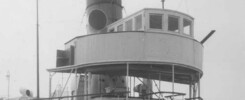
The day after her return from slipping at Southampton and the day after the Embassy had had her close encounter with Ballard Point, the Princess Elizabeth (pictured above backing out of Weymouth Harbour in 1963) started her 1965 season from Weymouth on Sunday 5th June with a one hour trip round Portland Harbour at 2pm and a two hour trip along the Dorset Coast to Lulworth Cove at 3pm. Unlike her immediate Cosens’s predecessor at Weymouth, the Consul, the Lizzie did not ever land passengers at Lulworth nor in her first two seasons at Weymouth in 1963 and 1964 did she ever go into the Cove itself. But for 1965, and starting on this first Sunday, she usually stuck her bow in to give the passengers a better view. On one balmy and windless day in August, I forget the date, she actually went right in.

The general pattern of sailings that summer was for morning cruises 11am to 12.15 “Towards the famous Portland Bill and the interesting Pennsylvania Castle” on Tuesdays and Thursdays, one hour trips round Portland Harbour at 2pm and the afternoon cruise to Lulworth Cove on Sundays, Mondays, Tuesdays and Thursdays, evening cruises 8pm to 9.15pm on the same days except Mondays and a day trip to Yarmouth, Isle of Wight 9.30am to 8pm on Wednesdays and, in the peak weeks, Fridays. When he brought the Princess Elizabeth to Weymouth in 1963, the Governor, Cdr Edmund Rhodes, was advised that these day trips should also pick up at Swanage, as Cosens had done in days gone by, but he resisted and, as each season wore on, the trips from Weymouth directly to Yarmouth without any call at Swanage did very well and were often a sell out or pretty nearly a sell out…
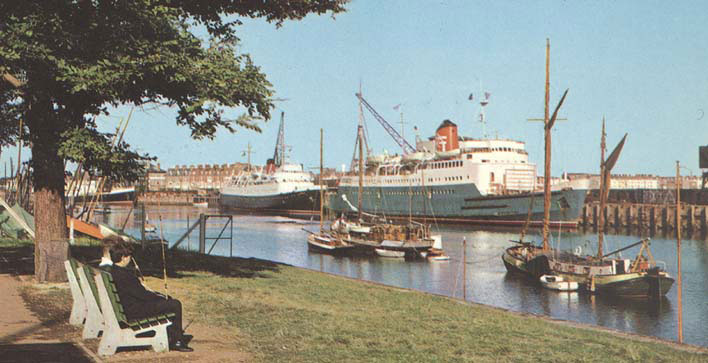
…despite competition in the day trip market from the former Newhaven to Dieppe ferry Lisieux which fetched up in Weymouth in 1965 on Fridays offering an excursion from Weymouth to Guernsey sandwiched between her crossings from and to St Malo on Thursday and Friday nights. The Lisieux is seen here with the dark red funnel berthed astern of either the Caesarea or Sarnia, I can’t tell which. The cargo vessel astern of her is likely to be the Rennes which normally ran between Newhaven and Dieppe but which for 1965 replaced her pretty much identical sister ship the Brest which had operated on the Channel Islands cargo service on and off from 1959 to early 1965.

The Princess Elizabeth’s master in 1965 was Capt Stanley Woods pictured here leaning on the docking telegraph on the port bridge wing. A resident of 101, Wilton Road, Southampton, Capt Woods had a master’s ticket in both steam and sail and had started his career with the Royal Mail Line on the South America run. On one such trip he had acquired a Spanish wife, a rather feisty lady who occasionally accompanied him on the Lizzie. He had subsequently spent some years doing freelance delivery jobs of ships here and there and spent some summers as master of the passenger vessels Anzio at Brighton and the Kiloran at Torquay. In 1963 he was, for a time, the mate of the Consul during her ill starred adventure on the Sussex Coast and for the first few weeks of the 1964 season was the mate on the Princess Elizabeth at Weymouth.
I had met him when he was mate of the Lizzie in 1964 so when the 1965 season started he knew of my burgeoning interest in ships and the sea and proved to be a most helpful mentor that summer encouraging my 14 year old self, getting me to steer the Lizzie and giving me several books on seamanship and navigation to take home to study. On these he tested me every time I came aboard. “Now then, John,” he would say “When the wind speed is around 20 knots how is that expressed on the Beaufort scale?.” “What is the difference between an occluding and an isophase light?” “The distance from A Head on the Portland Breakwater to the Sewer Buoy off Weymouth is 1.6 nautical miles and we are steaming at 11 knots, how long will it take us to get there?.” Those sort of questions and lots more sent me scurrying back home every night to my new text books to top up on maritime matters and make sure that I could stay one step ahead and get the answers to the questions right. It was a hugely beneficial experience for me and one for which I will forever be very grateful.
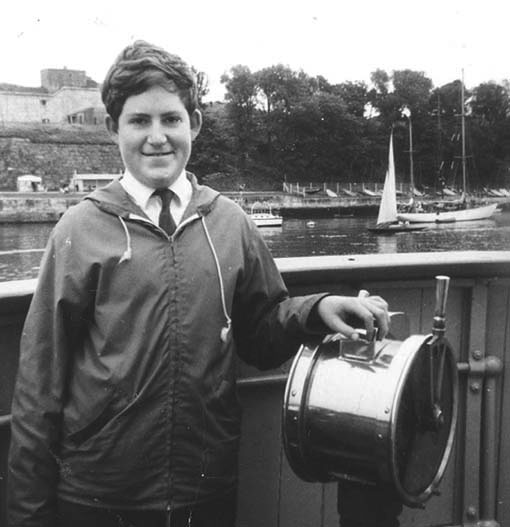
Here I am that summer standing next to the same docking telegraph with both photographs having been taken in quick succession by Mrs Eileen Pritchard, PSPS member number 1, a close personal friend of Capt Woods and a regular passenger on the Princess Elizabeth.
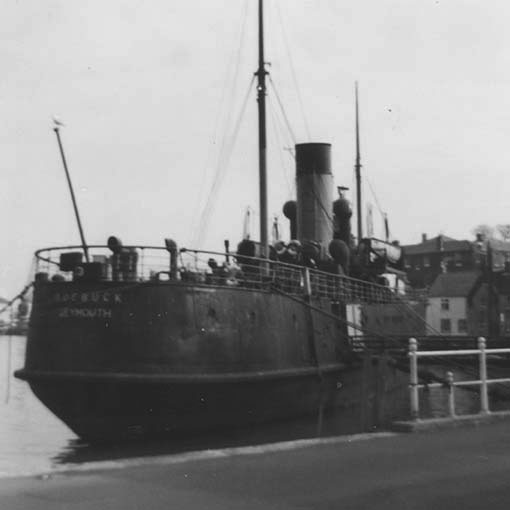
Meanwhile British Railways had just sold the Channel Islands cargo boat Roebuck (pictured out on the wires in the Cove at Weymouth), which had been withdrawn at the end of February 1965. A scratch crew was being assembled to steam her round to Lacmot’s scrapyard at Queenborough on the River Medway and Capt Woods had got wind of this and was assiduously lobbying for the job of taking her round. His plan of campaign was that after the Princess Elizabeth had finished her afternoon cruise to Lulworth Cove on a Friday he would go aboard the Roebuck with the Lizzie’s mate Arthur Drage and they would take her round to the Medway to arrive the following afternoon which would give them plenty of time to jump off and catch a train back to Weymouth in time for the trip round Portland Harbour at 2pm on the Lizzie on the Sunday. It was an idea which could have worked if everything had gone well but when Cdr Rhodes heard about it he put his foot down and said “no way” doubtless fearing that he was the one who would end up with a loss of revenue and a lot of grumpy potential passengers to deal with wanting the Sunday trips on the Lizzie which couldn’t happen if the master and mate didn’t get back in time.
I told Dad about this proposed voyage and it rather whetted his appetite. Although not a professional mariner, he was a marine artist and a keen yachtsman and rather fancied the idea of a coastal voyage on an old Channel Island cargo boat. So off he went first to see Mr Pepper, the Divisional Shipping Manager of British Railways at Weymouth, who told him that, as the Roebuck had been sold, this was now nothing to do with him, and then onto the Roebuck herself where the newly appointed master for the delivery voyage, a recently retired Commodore of P & O, said that he could go and that I could come along too.
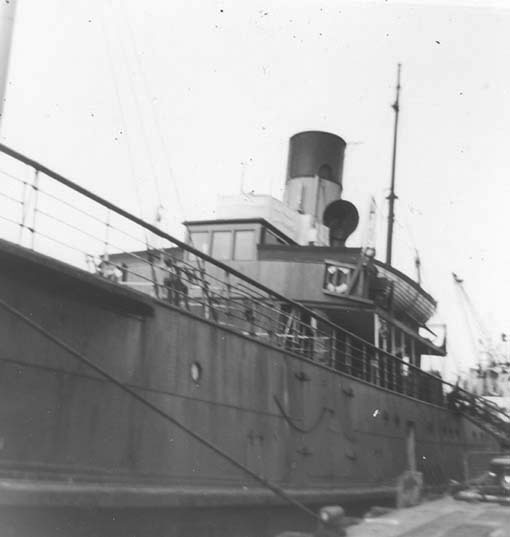
Dad and I therefore boarded the Roebuck on the morning of Thursday 29th July as supernumeraries only to find that the rest of the crew were in a not dissimilar mode with the captain’s son, aged 17, and Bert Williams, an elderly man who had sailed on the Roebuck’s maiden voyage in 1925, as ABs, a former boatswain as the un-certificated mate and three Royal Naval engine room artificers, moonlighting from their usual job, presiding over the engine and boiler rooms. Their wives were in charge of the galley range.
From today’s perspective of a safety culture with certificates and paperwork plus hours of work restrictions for everyone and everything from top to bottom however lowly including crew medicals, not to mention a separate set of articles and restrictions for anyone under the age of 18, it might all seem to have been a bit Heath Robinson or like a plot for an Ealing Comedy which in a way it sort of was. But we must remember that in those days there was absolutely no requirement for any certificates of competency of any sort for any of the crew at whatever level on any home trade cargo vessel. Many coasters of that era and earlier sailed around with un-certificated captains, officers and crews who had learnt their skills on the job and who had never passed any examination or obtained any form of certification in their lives at all. And, in general, like many brought up by experience, they were very good indeed at it.

The Roebuck left Weymouth just after lunch on Thursday 29th July passing the Princess Elizabeth waiting to sail on her 2pm Portland Harbour cruise with Capt Woods and Arthur Drage standing on deck watching the departure. I couldn’t quite make out when I waved to them if they were waving back or shaking their fists.

When clear of the harbour, the Weymouth pilot Capt Richardson disembarked into Brian Caddy’s pilot cutter. By that time there was not much work for a pilot in Weymouth with the masters of all the ships regularly using the port having their own pilotage certificates so Capt Richardson earned the greater part of his living running a bed and breakfast in Buxton Road. And Brian Caddy’s pilot cutter doubled as a twelve seater passenger launch running trips “Round the Warboats in Portland Harbour” from the Ferry Steps.

I felt on that trip that the Roebuck had rather the feel of a paddle steamer or even a luxury yacht about her. Of course she wasn’t luxuriously fitted out but there was lots of varnished woodwork and I thought that a few handily placed deck chairs would not have been out of place in the scene of this picture, taken on the starboard side, with the door to the captain’s cabin open on the right. “Another gin please steward!”

It was a breezy afternoon with the wind touching force 6 from the SW and the sea following us on the starboard quarter which made us cork-screw our way down the Channel.

We sailed to the south of the Isle of Wight and by sunset had made good progress and were well out to sea off the Sussex Coast approaching Beachy Head when Dad and I turned in. As the Roebuck had been laid up the accommodation was not in a great state but we had the six berth cabin on the port side amidships, used by occasional passengers on the Channel Island run, to ourselves and it was just fine when we had cleaned up the accumulated dirt, rubbish and old newspapers. Forward on the starboard side was the galley with its old coal range and giant antique kettle perpetually simmering on the hob. At the aft end of the ‘tween deck accommodation was the lovely and traditional officers’ saloon. Going in there and sitting down really made you feel that you had stepped back in time into another age.

This shot looking down onto the top of the hatch for the aft hold, just abaft the saloon, gives a good idea of the watertight integrity of cargo ships of that time. The weather deck with the sealed hatch is a deck lower than you might expect by looking at a profile of the ship with nothing to stop serious green seas coming over the top to enter this space although they would have had to be pretty massive to do that. And in those days all the cargo went through a hatch much smaller than the area below it and then had to be moved about by hand to the more distant parts of the hold by teams of men. It was a time before hatches were designed to extend over almost the whole hold to make lifting things in and out much easier and to cut down the need for too many dockers.

By morning we were round the North Foreland and on our way up the outer approaches to the Thames through the Princes Channel where we were overtaken by one of the Atlantic Steam Navigation Company’s new Tilbury to Rotterdam/Antwerp ferries. The man in the picture is the mate. I just can’t remember his name. Can anyone help? The following year when I took a summer job on the Channel Islands ferry Caesarea in my school holiday I encountered him again in a new incarnation as the ship’s carpenter.

Sailing on up the Thames with one of the engine room artificers taking a breather on deck.

We made good progress and were early for our ETA at Sheerness so dropped the anchor for a couple of hours in the morning to kill time. Looking forwards onto the starboard bridge wing you can see the anchor ball hoisted from the foremast.
We upped anchor after lunch and, in the days before the ready availability of VHF port radio to book pilots and make other arrangements, we entered the Medway in the early afternoon flying code flag G “I request a pilot”. Up the approach channel we steamed, giving me my first sight of the wreck of the Richard Montgomery, and on to Sheerness where the cutter eventually came out to deliver the necessary pilot. He took us into the Swale, swung on the engines off what is now Queenborough Pier and put us on the buoys.

The engine room telegraph rang “Finished With Engines” for the last time at about 3pm on Friday 30th July 1965 and our motley crew started to get things ready to go ashore by launch.
The engine room artificers decided that, as this was to be the Roebuck’s last voyage ever, they would not bother to shut down the engine, pumps and boiler in the usual way. They just turned off the fuel to the boiler and left the pumps to run themselves down as the steam ran out. It was also noted by this well behaved and nicely brought up youth that several members of this itinerant crew accompanied by their wives then moved round the ship with screwdrivers in hand quietly removing what Charles Dickens called “portable property” to secrete into a variety of their own personal and copious bags. I mentioned this to Dad who, pragmatic as ever, said that it was wrong to take anything of value from the ship but that if I wanted to have a souvenir from the trip maybe a flag, which would have no further use and had no future worth except as a bit of rag, might fit the bill. I still have the Roebuck’s last pilot flag tucked away in a drawer here in Weymouth half a century later.
We were ashore by 6pm. Dad and I took the train to London where we spent a night at the Bonnington Hotel in Bloomsbury before returning home to Weymouth the next day.
Although the Roebuck herself is now long gone she lives on in the Kirk Douglas movie “The Heroes of Telemark” which pops up on the television from time to time. She was chartered in the autumn of 1964 for the filming to play the role of the coaster hijacked by the Kirk Douglas character to take him from Norway to the UK. There are some wonderful shots of her temporarily renamed Galtesund, and filmed from Bob Wills’s small passenger launch Topaz, at sea with film star Richard Harris pushing a mine away from the hull with a big stick. She is seen departing from one quay in Poole Harbour to suggest Norway and arriving at another on the other side of the same harbour to represent Britain. And there is excellent internal footage of the bridge and the accommodation including the lovely officers’ saloon.

I was back on the Princess Elizabeth on Thursday 5th August to tell Capt Woods all about my exciting new nautical adventure only to have to answer another question: “How on earth did you and your Dad manage to wangle that?”
John Jones wrote on 30th June 2016:
I enjoyed the description of your trip on the Roebuck John. In some ways a harder time for many but as you say, there was not remotely the bureaucracy that surrounds everything today. Keeps people employed I suppose. I see Balmoral’s recent sailings have been curtailed whereas they might not have been fifty years ago.
Your adventure brought back memories of a trip on a coaster from Liverpool to Dublin around the same time. The father of a school friend ran a small one man ship repair business so he dealt with the engine problems experienced by many of the small coasters of the time. I remember visiting a little Spanish coaster at Runcorn for example where the hospitality of the crew towards two English schoolboys was great even given the language barrier!
The trip to Dublin. Neil’s father was the engineering ‘go to’ man for the Tyrells of Arklow which company subsequently became much bigger. In view of the relationship my friend Neil and I were able to take a trip to Dublin on a small coaster called the Marizell which was essentially an overnight trip. My abiding memory is of the coaster stopping in the middle of the Irish Sea while they put a line down to catch some mackerel which were then cooked for tea! The fish was truly fresh! I cannot imagine that in the busy seaways of today where speed is of the essence.
Kingswear Castle returned to service in 2023 after the first part of a major rebuild which is designed to set her up for the next 25 years running on the River Dart. The Paddle Steamer Kingswear Castle Trust is now fund raising for the second phase of the rebuild. You can read more about the rebuilds and how you can help if you can here.
John Megoran

